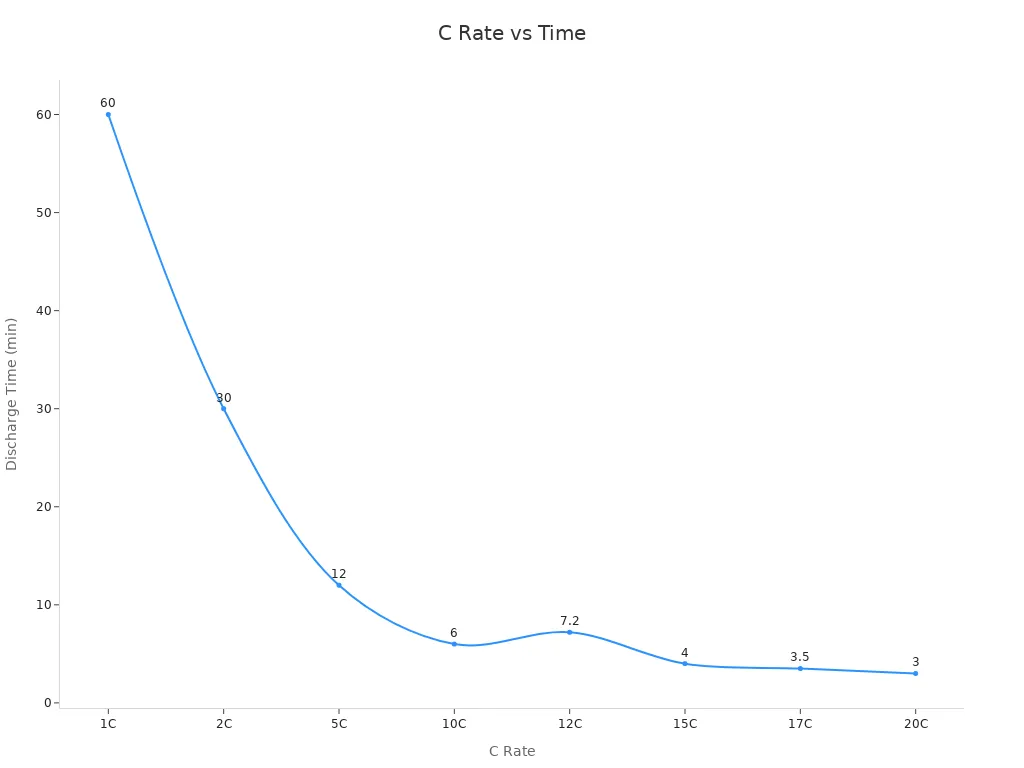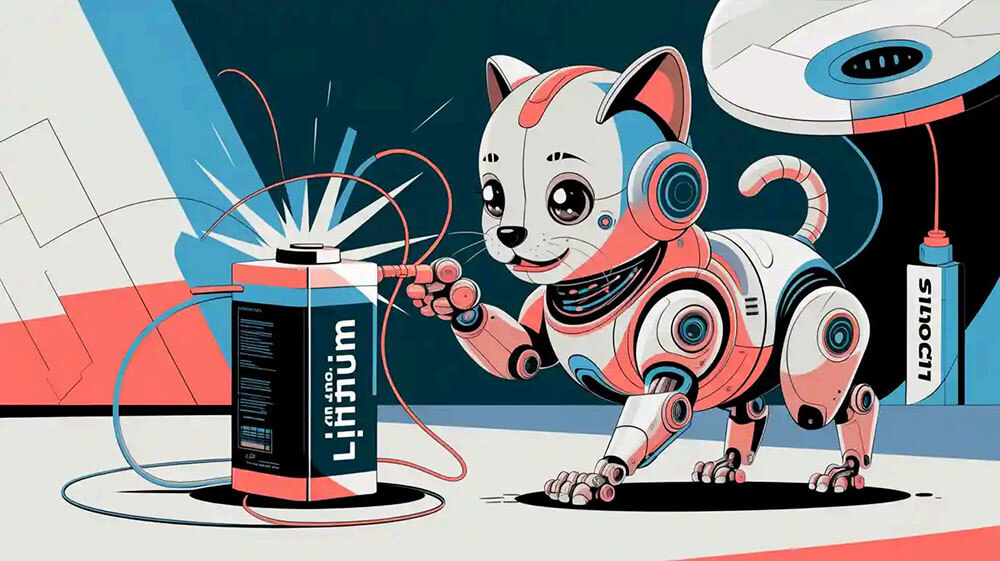Contents

What Is LiPo C Rating?
Definition and Explanation
The C rating of a LiPo battery shows how fast it can safely release energy. It tells you the highest current the battery can give without harm. For example, a 1000mAh battery with a 10C rating can release 10 amps steadily. This rating is important because it affects how well the battery works and how long it lasts.
Think of the C rating like a speed limit for energy flow. A higher C rating means the battery can release energy faster. This makes it good for powerful devices like drones or RC cars. But using the wrong C rating can cause overheating or make the battery less efficient.
How the C Rating Relates to Discharge Rate
The C rating decides the discharge rate, which is how much current the battery can give. You can find the discharge rate with this formula:
Current (A) = Capacity (Ah) × C Rating
For example, if you have a 3000mAh (or 3.0Ah) battery with a 15C rating, the highest discharge current is:
3.0Ah × 15C = 45A
This means the battery can safely give up to 45 amps. A higher C rating lets the battery deliver energy faster. This is important for devices that need quick bursts of power. But going over the rated discharge current can harm the battery or shorten its life.
Common C Rating Values and Their Implications
LiPo batteries have different C ratings, from 1C to over 100C. Here’s a simple guide to common values and what they mean:
| C Rating | What It Means | Example Calculation |
|---|---|---|
| 1C | Releases all energy in one hour (e.g., 2200mAh = 2.2A) | 2200mAh at 1C = 2.2A |
| 10C | Releases ten times the energy in one hour (e.g., 2200mAh = 22A) | 2200mAh at 10C = 22A |
| 15C | Can give 45A from a 3000mAh battery | 3000mAh at 15C = 45A |
| 25C | Can give 55A from a 2200mAh battery | 2200mAh at 25C = 55A |
| 20C+ | Made for high-power devices | N/A |

Most everyday devices work well with batteries rated between 25C and 50C. High-power devices, like racing drones, often need ratings above 50C. Picking the right C rating helps your device work safely and efficiently.
Key Takeaways
- The C rating of a LiPo battery shows how fast it gives energy. A higher C rating means energy flows faster, which is important for powerful devices.
- To find the most current a battery can give, use this formula: Current (A) = Capacity (Ah) × C Rating. This helps you pick the right battery for your device.
- Using the wrong C rating can be risky. A low C rating might make the battery too hot, and a very high one can waste money. Always match the C rating to what your device needs.
- Batteries with higher C ratings keep voltage steady and stay cooler. This makes them work better and last longer for your devices.
- When choosing a battery, think about your device’s power needs first. Devices like drones need higher C ratings, but simpler devices can use lower ones.
Why the C Rating Matters
How It Affects Battery Performance
The C rating impacts how well a LiPo battery works. A higher C rating lets the battery give more current. This is important for devices needing quick power, like racing drones or RC cars. These devices depend on high C ratings for speed and performance.
Batteries with higher C ratings keep voltage steady during use. This helps devices run smoothly, even with heavy power needs. They also produce less heat when giving high current. This makes them more efficient and helps them last longer.
Here’s a table showing how C rating affects discharge time:
| C-RATE | TIME |
|---|---|
| 1C | 1h |
| 2C | 30min |
| 5C | 12min |
| 10C | 6min |
| 15C | 4min |
| 20C | 3min |
Higher C ratings mean shorter discharge times. This fast energy release is key for devices needing lots of power quickly.

Dangers of Using the Wrong C Rating
Using the wrong C rating can be dangerous. A low C rating might not give enough current. This can cause the battery to overheat, get damaged, or even catch fire.
Using a very high C rating isn’t as risky but can waste money. It may not improve performance and costs more. Always pick a C rating that matches your device’s needs to avoid problems.
Choosing the Right C Rating for Your Device
Picking the right C rating keeps your device safe and efficient. Check your device’s power needs first. Devices like drones or RC cars need higher C ratings. Less demanding devices can use lower C ratings.
For example, if your device needs 30 amps, a 3000mAh battery with a 10C rating works well. This match improves performance and helps the battery last longer.
Knowing what the C rating is and how it fits your device helps you choose wisely. This ensures your device runs well without safety or efficiency issues.
Factors That Affect the C Rating
Importance of Battery Materials and Quality
The materials in a LiPo battery affect its C rating. Better materials make batteries last longer and work better. For example, lithium-ion batteries often have higher C ratings than older nickel-based ones. This is because they handle more power without getting too hot.
Smart designs also improve C ratings. Batteries with bigger electrodes can give more current. This makes them great for devices needing lots of power. High-quality parts also help batteries stay stable under heavy use, ensuring they work reliably.
Tip: Buy batteries from trusted brands. Good materials and designs mean safer and better performance.
Impact of Design and Manufacturing
How a battery is made affects its C rating. Batteries built with care can handle higher power. One key factor is internal resistance. Lower resistance helps the battery give more current without overheating or losing power.
Here’s a table showing what affects the C rating:
| Factor | Effect on C Rating |
|---|---|
| Internal Resistance | High resistance causes overheating and lowers performance. |
| Discharge Rate | Higher C ratings allow more current for powerful devices. |
| Heat Generation | Batteries with high C ratings stay cooler and last longer. |
Choose batteries made with strict standards. They perform better and last longer.
Effects of Environment and Usage
Where you use your battery changes its C rating. Extreme temperatures can hurt performance. Cold slows chemical reactions, lowering power. Too much heat can damage the battery by causing overheating.
How you use the battery also matters. Using it at full power often can wear it out. Batteries with high C ratings stay cooler and work better under heavy use. This is important for drones or electric vehicles needing steady power.
Note: Keep your battery away from extreme heat or cold. Follow the manufacturer’s instructions for best results.
How to Calculate and Understand the C Rating
Formula for Finding Discharge Rate
You can find the discharge rate using this formula:
Maximum Current (A) = C Rating × Battery Capacity (Ah)
This tells you how much current the battery can safely give. For example, a 5Ah battery with a 2C rating can provide:
2C × 5Ah = 10A
Here’s a table to show how it works:
| C-rate | What It Means | Example Calculation |
|---|---|---|
| 1C | Gives full energy in one hour | 1C × 5Ah = 5A |
| 2C | Gives twice the energy in one hour | 2C × 5Ah = 10A |
| 0.5C | Gives half the energy in one hour | 0.5C × 5Ah = 2.5A |
This formula helps you know the battery’s safe limits.
Example of C Rating Calculation
Let’s go through an example step by step. Imagine you have a 3000mAh (or 3.0Ah) battery with a 15C rating. To find the maximum current:
- Change the battery capacity to ampere-hours (Ah):
3000mAh = 3.0Ah - Multiply the capacity by the C rating:
3.0Ah × 15C = 45A
This means the battery can safely give up to 45 amps. Here’s another example in a table:
| Battery Capacity (Ah) | C Rating | Maximum Current (A) |
|---|---|---|
| 3.0Ah | 15C | 45A |
| 2.2Ah | 25C | 55A |
These steps help you understand what your battery can do safely.
Tips for Picking the Right C Rating
Choosing the right C rating is important for safety and performance. Use these tips to decide:
- Know Your Device’s Power Needs: Find out how much current your device needs. For example, if it needs 30A, pick a battery that can give at least 30A.
- Don’t Overload the Battery: A battery with a low C rating might overheat or break.
- Think About Efficiency: Higher C ratings give more power but aren’t always needed. Match the C rating to your device’s needs to save money.
For example, a 5500mAh battery with a 50C rating gives 275A. A 5000mAh battery with a 100C rating gives 500A. Choose based on what your device needs, not just the highest number.
Tip: Always check the manufacturer’s advice to ensure safety and compatibility.
FAQ
What does the C rating mean for battery safety?
The C rating shows how much current a battery can safely give. Using a low C rating battery in a high-power device can cause overheating or damage. Always match the C rating to your device’s needs to stay safe.
Can a higher C rating improve device performance?
A higher C rating lets the battery deliver energy faster. This helps devices like drones or RC cars that need quick power. But if your device doesn’t need high current, a higher C rating won’t help and costs more.
How do I calculate the discharge rate of a LiPo battery?
Use this formula:
Discharge Rate (A) = C Rating × Battery Capacity (Ah)
For example, a 2200mAh battery with a 20C rating gives:
2.2Ah × 20C = 44A. This helps you pick the right battery for your device.
What happens if I use a battery with the wrong C rating?
Using a low C rating battery can cause overheating or poor performance. A very high C rating may waste money without helping. Always check your device’s power needs to pick the right C rating.
Are higher C ratings always better?
Higher C ratings give more current but aren’t always needed. Devices with lower power needs work fine with lower C ratings. Choose a C rating that fits your device for the best results.





